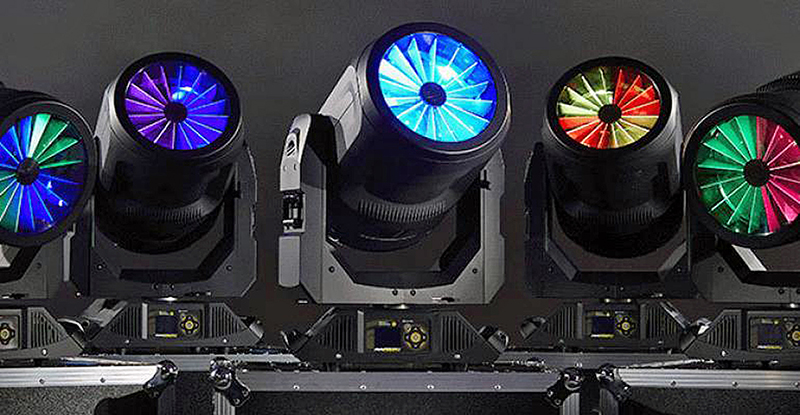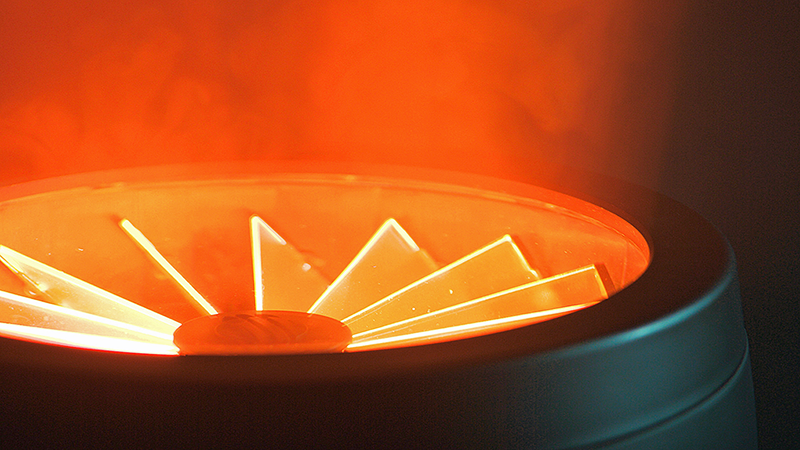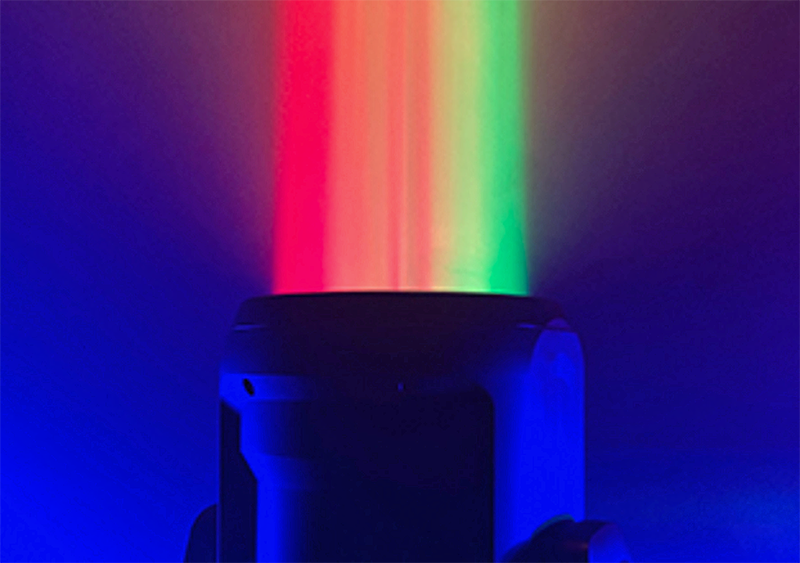
I had a pal of mine call me last month and ask if we’d seen the TurboRay yet. I mentioned that I had seen one at a trade show, but wasn’t sure what it was really capable of yet. He exclaimed, “Man, you need to get yourself a demo ASAP, this fixture is so much more than just a pretty face.” I valued this friend’s opinion so much that I decided it would be best for all of the PLSN readers if I just made a trip down to Austin to get the skinny on this unit, where High End Systems is manufacturing these fixtures themselves — right here in the USA.
It’s the unique fixtures that are unlike anything else out on the market that get me excited. I’m here to tell you that not only is the light unique in several ways, it lived up to my friend’s hype in more ways than I expected.

The Beam
The first thing anyone notices when they look at this fixture is the turbines that sit right by the clear protective lens in the front of the fixture. It looks like a throwback to the old days when the VL5 used similar looking louvers to change colors. But looks are all these two lights had in common. These turbine-looking louvers are actually used as the primary radial diffuser for the fixture, acting as a variable frost that can spread across the whole beam. We’ll get back to these later.
There are four 60-watt Osram Ostar RGBW LEDs mounted to a plate in a square configuration. A thin pipe sticks out from each cell on this plate to magnify and color mix the light output. Each LED is individually controlled. Above the four LEDs are four unsymmetrical shaped lenses mounted on one plate in a genius configuration that is symmetrical when the lenses line up. It gets the four LED cells to converge into one point as best they can, which with this wash fixture works well. This plate of lenses moves back and forth on an optical train zooming the beam in and out as it moves. With all the diffusers open and the beam tight, I see a collimated 8° shaft of light that reminds me of an old Ray Light bulb in a par. It has a solid hi powered center beam, shrouded in a halation of dim light. When zoomed to full and the primary diffuser in place, the size of the beam is at 28°.
With the primary radial diffusion (the turbine looking louvers) closed at full frost, the light output is throttled down closer to 3500-4000 lumens output, and the fixture becomes very useful as eye candy. The speed of these louvers is very fast. I found I could make a great chase by opening and closing them twice per second. It’s like a color strobe. The beam seems to disappear, yet I still see the colored source displayed on the frosted blades.
The fixture comes with some effects to alter the shape. The TurboRay has an animation effect it can achieve by rolling two quadrants of gobos back and forth in front of the four outputs. One is a tiny dot gobo while the other is a hatch type (crossed lines). Because this is a wash light, I cannot get the patterned beams overly sharp, but the gobo/animation effect provides a flickering output effect as well as a water texture on the wall. On the gobo wheel is another lens called the secondary diffusion. With this lens in we see more of a hard edge beam at its tightest. I do notice that if we take the secondary diffusion to full, one can see all the individual colored LEDs on the wall. This is a feature in some other lights that is easily emulated here.
The dimming is all 16-bit and smooth as silk. The COB chips emit over 6000 lumens, so it gets fairly bright with all the colors at full. The sync strobe functions flawlessly, but what I find very impressive is the random strobe function. When enabled, the four onboard LED cells randomly chase between themselves, so the fixture itself never really stops emitting light and going dark. A rig of about 50 of these fixtures randomly strobing would be something unique and glorious.

Colors
This is where this puppy excels. The TurboRay has an additive color engine. With the Osram Ostar COBs, a medium red is the best they can do. Similar to almost every RGBW light source, when all the colors are at full the output the beam has a slight pink hue. The blue hue is a very rich medium blue. The yellow and magenta colors mix solidly together.
With the four equidistant LED cells, half colors excel in ways I have never seen before. Splitting the color in half by placing the two top cells in one color and a different one in the bottom two cells is something we’ve all seen before. But when I put the opposite diagonal cells in blue, then put the other two in amber, we view this remarkable effect. The beam from one angle looked like it had a blue outside but a hot flaming amber shooting down the middle. If you panned the light in the other direction, the hues changed with the amber surrounding a blue center. I chased the two cues back and forth, and the effect was certainly a wow lighting moment.
In the past, High End would include up to 60 macros with a fixture, including all kinds of color chases. Users had to scroll through bunches of these prebuilt effects to find something cool. Not that there was anything wrong with that, but High End has come up with a superior method for making chases that I much preferred. First of all, there are now only 12 macros. One can still adjust the speed and amplitude of an effect, but the way the light internally knows what to do after that is something I can’t figure out — but I like it. To explain, the programmer takes the four cells and separates them into red, green, blue, and white colors. Then she activates a macro that will chase these four cells through those assigned colors in the same progression, so the viewer never sees any other colors —even when they crossfade in a slower chase.
I’m told they now offer a crossfade time channel for the macros. This means I can fade right into another macro or a static look with a desired fade time. By now I have the multicolor chase going bananas. I ask my programmer to give me a ten second cross fade from this disco chase to a solid magenta beam. The cue is executed and the chase takes a full ten seconds to linearly stop the intensity flickering while all cells go to magenta. Normally, one would have to write some intricate cues on your console of choice to achieve this. It took mere seconds on the Hog 4.
Most designers cannot live without the sexy ruby red or deep blue hues. So High End put a color wheel system in place. The engineering is genius, as the wheel sits directly in front of the four LEDs. The wheel holds 16 slots, four per LED cell. Besides the open slot, there are non-replaceable deep red, dark blue and 3200° CTO filters. By messing around with this wheel, the user can stop it at specific places and cut out parts of the beam to give the user some cool individual thin as well as split color beams. One can run a standard red white flag chase like the old days, but with four cells and four individual half red and white beams, the end result is broken up, unprecedented and magnificent.
The fixture is well-thought-out for camera use. There is a channel for an electronic color correction that can be applied to any color mix, ranging from 2200 to 8000°. Between the variable front diffusion level, optics and color correction, it has everything one needs to get the perfect shot. There are PWM settings to choose from to ensure the output is flicker free. It can go all the way to 17.6 kHz — ensuring great results with 4K cameras. Fan speed can be controlled from the desk and includes a silent mode. The patented High End Haze Zero effect keeps the front lens shielded from fogging up.
Special mention must be made to the louvers as an architectural part of the fixture. High End has purposely polished the one end of each louver that is closest to the viewer’s eye. This results in each blade accept light at one end, while the opposite buffed edge just explodes with color.
The smooth curved shell is made from sturdy polycarbonate material. The 50-pound fixture is compact enough, with handles on the base and yoke, for one person to hang. It can take in 100-240 volts through a powerCON TRUE1 connector. DMX is fed through 5-pin XLR in/outs or RS-485 Art-Net or sACN via Ethernet. The fixture can pan 540° in 2.5 seconds and tilt 239° in 1.75. The maximum wattage of the light is 500 watts, and it has an IP20 rating. Standard mode has 53 DMX channels while the reduced mode requires 25.

At a Glance:
Distinctive Styling, Unique Looks
There’s a new style wash light in town that offers functions unlike anything else on the market through the use of four 60W Osram Ostar RGBW LED cells and the eye-catching louvered turbines in the front of the fixture that get used as the primary radial diffuser for the fixture, acting as a variable frost that can spread across the whole beam.
HES TurboRay
PROS: Brilliant use of two diffusers, architecturally pleasing look, great split colors, random strobe function is sweet.
CONS: A lot of halation emitted with the tight beam. (But some may call this a feature.)
FEATURES
- Additive LED RGBW color mixing system
- Quadrant control over the four LEDs
- Distinctive-looking radial diffusers
- Powerful narrow beam for aerial effects
- Smooth and even wash with a 3:1 zoom range
- RGBW Color Mixing; Linear CTO
- Custom animated gobo wheel
- LED imaging unlocking primary color aerials
- TurboRay Hazefree lens coating technology
SPECS
- Light Source: Four 60W Osram Ostar RGBW LEDs
- Max Wattage: 500W
- Beam Angles: 3° (narrow beam), 8-24° (wash)
- Color Temp: 2800°-8000°K
- Pan/Tilt: 540°/239°
- Size: 26 x 16.4 x 11.7”
- Weight: 50.1 lbs.
- MSRP: Contact Dealer
Manufacturer: High End Systems
More Info: www.highend.com


